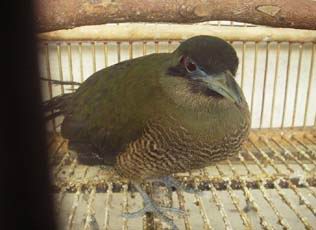Sumatran Cuckoo Rediscovered: Lampung Sumatra
 A Sumatran ground cuckoo brought great delight to Indonesian ornithologists when it was recently rediscovered in Lampung, Sumatra’s southernmost province, after the rare bird had been mistakenly declared extinct for over a century.
A Sumatran ground cuckoo brought great delight to Indonesian ornithologists when it was recently rediscovered in Lampung, Sumatra’s southernmost province, after the rare bird had been mistakenly declared extinct for over a century.
The protected Carpoccocyx viridis species, locally called tokhtor, was not detected in its native Sumatran forest habitat by means of camera traps. Instead, it was found by surveyors of the Wildlife Conservation Society-Indonesia Program (WCS-IP) in mid-January at the house of a bird trader in West Lampung. The bird had suffered an injury to its leg when it was snared as Oyos Saroso reports from Bandar Lampung.
The cuckoo has now been relocated to the society’s Way Canguk research station for rehabilitation before it is released.
The rediscovery of the captured tokhtor followed several reports from local residents on sightings received by WCS-IP researchers in Bukit Barisan National Park (TNBBS), West Lampung. Staffers from the WCS-IP Way Canguk station in Lampung responded by conducting more in-depth surveys.
It took researchers six months to survey fixed locations in TNBBS, using questionnaires and camera traps to track the cuckoo’s presence and distribution.
Through the hidden cameras, Way Canguk researchers have so far monitored Sumatran tigers (Panthera tigris sumatrae) and their prey, Sumatran elephants (Elephas maximus sumatranus), and other protected animals.
Based on new field data, the survey areas were expanded to cover Way Canguk, Sukaraja, Kubu Perahu and Ranau.
While no cuckoos were discovered during the July-December 2006 survey period, a WCS-IP survey was underway in the regency’s Liwa market area in mid-January when the bird was discovered in the bird trader’s home.
Meyner Nusalawo, head of the Way Canguk Conservation Research and Training Station in TNBBS, said the existence of the Sumatran ground cuckoo there, whose whereabouts had been unknown for at least a century, was a surprise to wildlife researchers and conservationists around the world.
The tokhtor is one of Sumatra’s endemic bird species. Its existence was previously known only from the eight specimens in museums that dated before 1910, a collection derived from the Bukit Barisan mountain range to the island’s south.
A live bird was reportedly spotted on Nov. 11, 1997 in TNBBS’ Sukaraja area in a primary forest at an altitude of 500 m (Zetra et al, 2002), and in July 2005 in Way Canguk by a WCS-IP team. But the survey team was unable to catch the bird.
The Sumatran cuckoo population on the island is not known. But further investigation indicated that the injured bird was obtained from a local hunter who used snares in the area of Buluh Handak, Penyungkaian, West Lampung.
A middleman, identified only by his initial T, said bird hunters very rarely found this bird in the forest, probably because of the altitude of its natural habitat or its color, which provided camouflage among foliage.
Neither did they hear its calls, which typically sound like its name. However, several West Lampung hunters have claimed that the Sumatran cuckoo’s calls have a high pitch like that of an eagle.
The limited tokhtor distribution led to the inclusion of this species on the Red List of the International Union for Conservation of Nature and Natural Resources (IUCN). The Sumatran ground cuckoo was even once declared extinct after it was “lost” for the past century.
The meager knowledge of local hunters of the bird’s presence has also caused difficulty in identifying the species through questionnaires. Its less appealing calls discourage bird catchers, in addition to a low market price due to a lack of buyers.
The Sumatran ground cuckoo thus belongs to the category of critical bird species, despite recent information enabling its review, because it had not been found by researchers or experienced hunters as early as 1916.
A carnivore, its favorite prey includes garden lizards (Mabuoya multifasciata), forest rats, larvae, frogs, crickets and earthworms. A cuckoo consumes four to five lizards daily.
Long & Collar (2002) gave an almost identical description of the Kalimantan tokhtor, or the Bornean ground cuckoo (Carpoccocyx radiatus). Research in Kalimantan recorded that the Kalimantan cuckoo eats land snails, frogs, earthworms, small snakes, cockroaches and bees.
Available information on its prey confirms a theory that the Sumatran tokhtor has the function of controlling the population of other organisms like lizards, frogs, bees, insects and snakes.
The sustained presence of natural habitat is crucial for the survival of various rare wildlife species in Sumatra, including the elusive tokhtor.
The growing pace of deforestation in the TNBBS since 1972 has caused the natural habitat to shrink even further, thus threatening the existence of all protected wildlife.
Oyos Saroso